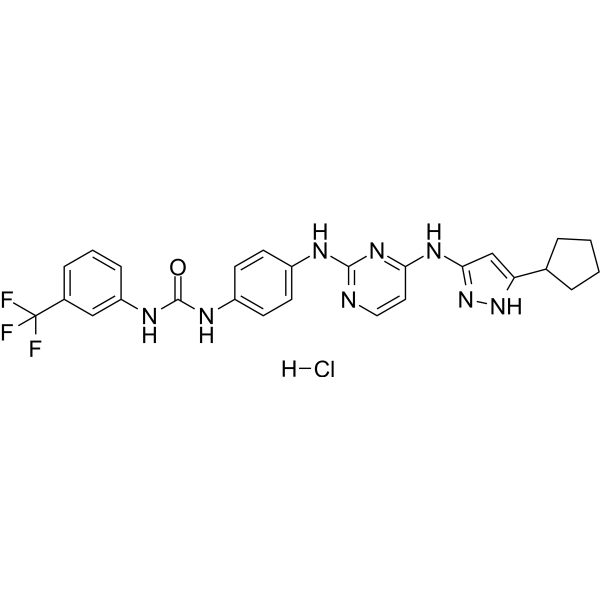Physicochemical Properties
| Molecular Formula | C26H26CLF3N8O |
| Molecular Weight | 558.985853672028 |
| Exact Mass | 558.187 |
| CAS # | 2926498-81-7 |
| Related CAS # | CD532;1639009-81-6 |
| PubChem CID | 162640520 |
| Appearance | White to off-white solid powder |
| Hydrogen Bond Donor Count | 6 |
| Hydrogen Bond Acceptor Count | 9 |
| Rotatable Bond Count | 7 |
| Heavy Atom Count | 39 |
| Complexity | 759 |
| Defined Atom Stereocenter Count | 0 |
| InChi Key | JEMDMVHTFBVJDO-UHFFFAOYSA-N |
| InChi Code | InChI=1S/C26H25F3N8O.ClH/c27-26(28,29)17-6-3-7-20(14-17)33-25(38)32-19-10-8-18(9-11-19)31-24-30-13-12-22(35-24)34-23-15-21(36-37-23)16-4-1-2-5-16;/h3,6-16H,1-2,4-5H2,(H2,32,33,38)(H3,30,31,34,35,36,37);1H |
| Chemical Name | 1-[4-[[4-[(5-cyclopentyl-1H-pyrazol-3-yl)amino]pyrimidin-2-yl]amino]phenyl]-3-[3-(trifluoromethyl)phenyl]urea;hydrochloride |
| HS Tariff Code | 2934.99.9001 |
| Storage |
Powder-20°C 3 years 4°C 2 years In solvent -80°C 6 months -20°C 1 month Note: Please store this product in a sealed and protected environment, avoid exposure to moisture. |
| Shipping Condition | Room temperature (This product is stable at ambient temperature for a few days during ordinary shipping and time spent in Customs) |
Biological Activity
| Animal Protocol |
Animal/Disease Models: Homozygous nu/nu (nude) mice with SHH-subtype MYCN-expressing medulloblastoma[1] Doses: 25 mg/kg Route of Administration: Ip twice weekly for 3 weeks Experimental Results: diminished the level of MYCN protein and tumor volume and increases survival. |
| References |
[1]. Drugging MYCN through an allosteric transition in Aurora kinase A. Cancer Cell. 2014 Sep 8;26(3):414-427. [2]. N-Myc Drives Neuroendocrine Prostate Cancer Initiated from Human Prostate Epithelial Cells. Cancer Cell. 2016 Apr 11;29(4):536-547. |
Solubility Data
| Solubility (In Vitro) | DMSO : 100 mg/mL (178.89 mM) |
| Solubility (In Vivo) |
Solubility in Formulation 1: 2.5 mg/mL (4.47 mM) in 10% DMSO + 40% PEG300 +5% Tween-80 + 45% Saline (add these co-solvents sequentially from left to right, and one by one), suspension solution; with sonication. For example, if 1 mL of working solution is to be prepared, you can add 100 μL of 25.0 mg/mL clear DMSO stock solution to 400 μL PEG300 and mix evenly; then add 50 μL Tween-80 + to the above solution and mix evenly; then add 450 μL normal saline to adjust the volume to 1 mL. Preparation of saline: Dissolve 0.9 g of sodium chloride in 100 mL ddH₂ O to obtain a clear solution. (Please use freshly prepared in vivo formulations for optimal results.) |
| Preparing Stock Solutions | 1 mg | 5 mg | 10 mg | |
| 1 mM | 1.7889 mL | 8.9447 mL | 17.8894 mL | |
| 5 mM | 0.3578 mL | 1.7889 mL | 3.5779 mL | |
| 10 mM | 0.1789 mL | 0.8945 mL | 1.7889 mL |
